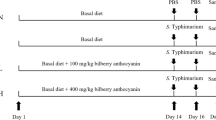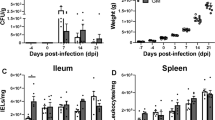Abstract
The study aimed to determine the effects of orally supplemental zinc on body weight, Salmonella invasion, serum IgA, intestinal histomorphology, and immune response of Salmonella enterica serovar Typhimurium (S. typhimurium)–challenged young pigeons. A total of 72 healthy White King pigeons (25 days old) with similar weight were randomly assigned to 3 treatments with six replicate cages. The 3 treatments were unchallenged, S. typhimurium–challenged, and S. typhimurium–challenged orally supplemented with 1 mg zinc per bird. Salmonella infection decreased (P < 0.05) the body weight, the bursa index, the serum IgA content, and the villus height/crypt depth ratio in the ileum, but increased the neutrophil proportion (P < 0.001) and the mRNA expressions of IL-1β and IL-8 in the jejunum (P < 0.05). Orally supplemental zinc reduced (P = 0.007) the bacterial load in the liver and improved (P < 0.05) the body weight, the bursa index, the serum IgA content, the villus height/crypt depth ratio, and the NOD-like receptor family pyrin domain containing 3 (NLRP3) protein expression, as well as tended to increase (P = 0.064) the protein abundance of caspase-1 of the jejunum, but did not alleviate the high level of neutrophil proportion and IL-1β mRNA expression of the jejunum (P > 0.05). The results indicated that oral zinc supplementation improved the intestinal mucosal morphology and enhanced the immune response, as well as activated caspase-1-dependent cell pyroptosis pathways in the jejunal epithelium, thereby restricting Salmonella invasion of the challenged young pigeons.



Similar content being viewed by others
Data availability
The data of this study will be made available on reasonable request.
The study was carried out in accordance with the guidelines set by the Animal Care and Use Committee (permit number: SYXK-2017–0005) of the Institute of Animal Husbandry and Veterinary Medicine, Beijing Academy of Agriculture and Forestry Sciences (IAHVM-BAAFS), Beijing, China. The protocols were approved by the Animal Care and Use Committee of IAHVM-BAAFS.
References
Soncini G, Valnegri VL, Vercellotti L, Colombo F, Valle D, Franzoni M, Bersanii C (2006) Investigation of Campylobacter in reared game birds. J Food Prot 69:3021–3024
McCrea BA, Tonooka KH, VanWorth C, Boggs CL, Atwill ER (2006) Prevalence of Campylobacter and Salmonella species on farm, after transport, and at processing in specialty market poultry. Poult Sci 85:136–143
Matsubara R, Fukuda Y, Murakoshi F, Nomura O, Suzuki T, Tada C, Nakai Y (2017) Detection and molecular status of Isospora sp. from the domestic pigeon (Columba livia domestica). Parasitol Int 66:588–592
Akbarmehr J (2010) Isolation of Salmonella spp from poultry (ostrich pigeon and chicken) and detection of their hilA gene by PCR method. African Journal of Microbiology Research 4(24):2678–2681
Gong J, Zhang J, Xu M, Zhu C, Yu Y, Liu X, Kelly P, Xu B, Wand C (2014) Prevalence and fimbrial genotype distribution of poultry Salmonella isolates in China (2006 to 2012). Appl Environ Microbiol 80(2):687–693
Lynch MJ, Leon-Velarde CG, McEwen S, Odumeru JA (2004) Evaluation of an automated immunomagnetic separation method for the rapid detection of Salmonella species in poultry environmental samples. J Microbiol Methods 58:285–288
Pezoa D, Yang HJ, Blondel CJ, Santiviago CA, Andrews-Polymenis HL, Contreras I (2013) The type VI secretion system encoded in SPI-6 plays a role in gastrointestinal colonization and systemic spread of Salmonella entericafserovar Typhimurium in the chicken. PLoS One 8:e63917
Yang X, Huang J, Zhang Y, Liu S, Chen L, Xiao C, Zeng H, Wei X, Gu Q, Ying Li, Wang J, Ding Y, Zhang J, Wu Q (2020) Prevalence, abundance, serovars and antimicrobial resistance of Salmonella isolated from retail raw poultry meat in China. Total Environment 713:136385
Rupiper DJ (1998) Diseases that affect race performance of homing pigeons. Part II: bacterial, fungal, and parasitic diseases. J Avian Med Surg 12:138–148
Kaczorek-Lukowska E, Sowinska P, Franaszek A, Dziewulska D, Malaczewska J, Stenzel T (2021) Can domestic pigeon be a potential carrier of zoonotic Salmonella? Transbound Emerg Dis 68(4):2321–2333
Brandao-Neto J, Stefan V, Mendonca BB, Bloise W, Castro AVB (1995) The essential role of zinc in growth. Nutr Res 15(3):335–358
Nowak JE, Harmon K, Caldwell CC, Wong HR (2012) Prophylactic zinc supplementation reduces bacterial load and improves survival in a murine model of sepsis. Pediatr Crit Care Med 13(5):e323–e329
Wiegand S, Zakrzewski SS, Eichner M, Schulz E, Gunzel D, Pieper P, Rosenthal R, Barmeyer C, Bleich A, Dobrindt U, Schulzke JD, Bucker R (2017) Zinc treatment is efficient against Escherichia coli α-haemolysin-induced intestinal leakage in mice. Sci Rep 7:45649
Roy SK, Raqib R, Khatun W, Azim T, Chowdhury R, Fuchs GJ, Sack DA (2008) Zinc supplementation in the management of shigellosis in malnourished children in Bangladesh. Eur J Clin Nutr 62(7):849–855
Phatthalung PN, Min J, Wang F (2021) Macrophage-mediated defensive mechanisms involving zinc homeostasis in bacterial infection. Infectious Microbes & Diseases. https://doi.org/10.1097/IM9.0000000000000058
Debski B (2016) Supplementation of pigs diet with zinc and copper as alternative to conventional antimicrobials. Pol J Vet Sci 19:917–924
Feldmann HR, Williams DR, Champagne JD, Lehenbauer TW, Aly SS (2019) Effectiveness of zinc supplementation on diarrhea and average daily gain in pre-weaned dairy calves: a double-blind, block-randomized placebo-controlled clinical trial. PLoS One 14(7):e0219321
Zhang B, Shao Y, Liu D, Yin P, Guo Y, Yuan J (2012) Zinc prevents Salmonella enterica serovar Typhimurium-induced loss of intestinal mucosal barrier function in broiler chickens. Avian Pathol 41:361–367
Shao Y, Lei Z, Yuan J, Yang Y, Guo Y, Zhang B (2014) Effect of zinc on growth performance, gut morphometry, and cecal microbial community in broilers challenged with Salmonella Typhimurium. J Microbiol 52:1002–1011
Oh HJ, Park YJ, Cho JH, Song MH, Gu BH, Yun W, Lee JH, An JS, Kim YJ, Lee JS, Kim S, Kim H, Kim ES, Lee BK, Kim BW, Kim HB, Cho JH, Kim MH (2021) Changes in diarrhea score, nutrient digestibility, zinc utilization, intestinal immune profiles, and fecal microbiome in weaned piglets by different forms of zinc. Animals (Basel) 11(5):1356
Livak KJ, Schmittgen TD (2001) Analysis of relative gene expression data using real-time quantitative PCR and the 2(T)(-Delta Delta C) method. Methods 25:402–408
Sales J, Janssens GPJ (2003) Nutrition of the domestic pigeon (Columba livia domestica). World’s Poultry Science Journal 59:221–232
Xie W, Fu Z, Pan N, Yan H, Wang X, Gao C (2019) Leucine promotes the growth of squabs by increasing crop milk protein synthesis through the TOR signaling pathway in the domestic pigeon (Columba livia). Poult Sci 98(11):5514–5524
Pasmans F, Baert K, Martel A, Bousquet-Melou A, Lanckriet R, De Boever S, Van Immerseel F, Eeckhaut V, de Backer P, Haesebrouck F (2008) Induction of the carrier state in pigeons infected with Salmonella enterica subspecies enterica serovar typhimurium PT99 by treatment with florfenicol: a matter of pharmacokinetics. Antimicrob Agents Chemother 52(3):954–961
Finlay BB, Brumell JH (2000) Salmonella interactions with host cells: in vitro to in vivo. Philosophical Transactions of the Royal Society B: Biological Sciences 355(1397):623–631
Liu JZ, Jellbauer S, Poe AJ, Ton V, Pesciaroli M, Kehl-Fie TE, Restrepo NA, Hosking MP, Edwards RA, Battistoni A, Pasquali P, Lane TE, Chazin WJ, Vogl T, Roth J, Skaar EP, Raffatellu M (2012) Zinc sequestration by the neutrophil protein calprotectin enhances Salmonella growth in the inflamed gut. Cell Host Microbe 11:227–239
Nickerson KP, Senger S, Zhang Y, Lima R, Patel S, Ingano L, Flavahan WA, Kumar DKV, Fraser CM (2018) Salmonella, typhi colonization provokes extensive transcriptional changes aimed at evading host mucosal immune defense during early infection of human intestinal tissue. EBioMedicine 31:92–109
Reynolds JV (1996) Gut barrier function in the surgical patients. Br J Surg 83:1668–1671
Lamb-Rosteski JM, Kalischuk LD, Inglis GD, Buret AG (2008) Epidermal growth factor inhibits Campylobacter jejuni induced claudin-4 disruption, loss of epithelial barrier function, and Escherichia coli translocation. Infect Immun 76:3390–3398
Hu C, Song J, Li Y, Luan Z, Zhu K (2013) Diosmectite-zinc oxide composite improves intestinal barrier function, modulates expression of pro-inflammatory cytokines and tight junction protein in early weaned pigs. Br J Nutr 110:681–688
Reddy EA, Shaw AV, Crump JA (2010) Community-acquired blood stream infections in Africa: a systematic review and meta-analysis. Lancet Infectious Diseases 10:417–432
Peterson DG, Scrimgeour AG, McClung JP, Koutsos EA (2008) Moderate zinc restriction affects intestinal health and immune function in lipopolysaccharide-challenged mice. J Nutr Biochem 19:193–199
Kim B, Lee WW (2021) Regulatory role of zinc in immune cell signaling. Moleculer Cells 44:335–341
Monteith AJ, Skaar EP (2021) The impact of metal availability on immune function during infection. Trends Endocrinol Metab 32(11):916–928
Gordon S, Taylor P (2005) Monocyte and macrophage heterogeneity. Nat Rev Immunol 5:953–964
Singh S (2019) Zinc oxide nanoparticles impacts: cytotoxicity, genotoxicity, developmental toxicity, and neurotoxicity. Toxicol Mech Methods 29(4):300–311
Lei XJ, Kim IH (2020) Evaluation of coated zinc oxide in young pigs challenged with enterotoxigenic Escherichia coli K88. Animal Feed Science and Technology 262:114399
Hasan R, Rink L, Haase H (2013) Zinc signals in neutrophil granulocytes are required for the formation of neutrophil extracellular traps. Innate Immun 19:253–264
Segal AW (2005) How neutrophils kill microbes. Annu Rev Immunol 23:197–223
Brough D, Pelegrin P, Rothwell NJ (2009) Pannexin-1-dependent caspase-1 activation and secretion of IL-1beta is regulated by zinc. J Immunol 39:352–358
Holly MK, Han X, Zhao EJ, Crowley SM, Allaire JM, Knodler LA, Vallance BA, Smith JG (2020) Salmonella enterica infection of murine and human enteroid-derived monolayers elicits differential activation of epithelium intrinsic inflammasomes. Infect Immun 88:e00017-20
Heckert RA, Estevez I, Russek-Cohen E, Pettit-Riley R (2002) Effects of density and perch availability on the immune status of broilers. Poult Sci 81:451–457
Ahiwe EU, Abdallh ME, Chang EP, Al-Qahtani M, Omede AA, Graham H, Iji PA (2019) Influence of autolyzed whole yeast and yeast components on broiler chickens challenged with salmonella lipopolysaccharide. Poult Sci 98:7129–7138
Cui H, Jing F, Xi P (2003) Pathology of the thymus, spleen and bursa of Fabricius in zinc-deficient ducklings. Avian pathology : journal of the WVPA 32:259–264
Davis SK, Selva KJ, Kent SJ, Chung AW (2020) Serum IgA Fc effector functions in infectious disease and cancer. Immunology Cell Biology 98(4):276–286
Acknowledgements
This study was supported by the Utility Fund of the Beijing Academy of Agriculture and Forestry Science under Grant [number: XMSSYJJ202004] and the innovation capacity building project of the Beijing Academy of Agriculture and Forestry Science under Grant [number: KJCX 20200404].
Funding
The Utility fund of Beijing Academy of Agriculture and Forestry Science,XMSSYJJ202004,Yuxin Shao,The Innovation capacity building project of Beijing Academy of Agriculture and Forestry Science,KJCX 20200404,Zheng Wang
Author information
Authors and Affiliations
Contributions
Xing Li carried out the experiments. Shaohua Du, Xiaoshan Sun, and Jianguo Huang processed the data. Zheng Wang and Yuxin Shao designed the experiment and wrote the paper. The final manuscript was read and approved by all the authors.
Corresponding author
Ethics declarations
Competing interests
The authors declare no competing interests.
Additional information
Publisher's note
Springer Nature remains neutral with regard to jurisdictional claims in published maps and institutional affiliations.
Zheng Wang and Xing Li contributed equally to this work
Rights and permissions
About this article
Cite this article
Wang, Z., Li, X., Du, S. et al. Protective Effects of Zinc on Salmonella Invasion, Intestinal Morphology and Immune Response of Young Pigeons Infected with Salmonella enterica Serovar Typhimurium. Biol Trace Elem Res 200, 4817–4827 (2022). https://doi.org/10.1007/s12011-021-03057-7
Received:
Accepted:
Published:
Issue Date:
DOI: https://doi.org/10.1007/s12011-021-03057-7




